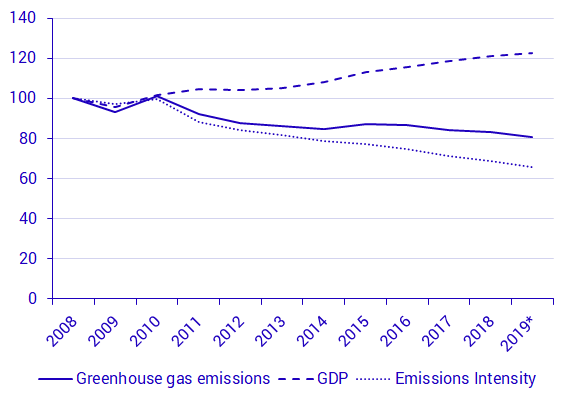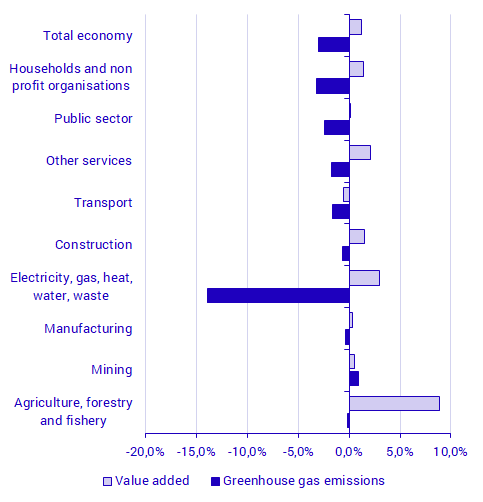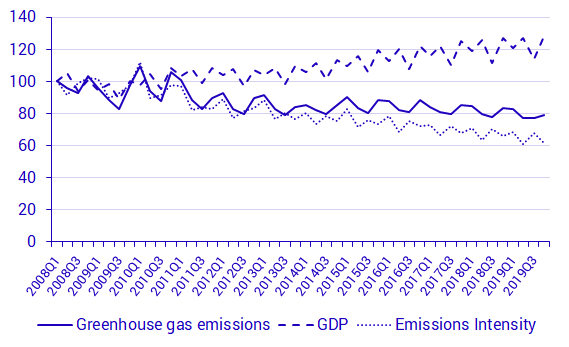Environmental Accounts – Emissions to air Q4 2019
Greenhouse gas emissions intensity for Sweden’s economy decreased in 2019
Statistical news from Statistics Sweden 2020-05-14 9.30
Greenhouse gas emissions intensity for Sweden’s economy decreased by 4 percent in 2019 compared to 2018, according to preliminary statistics for 2019. This is due to a 3 percent decrease in greenhouse gas emissions and economic growth of 1 percent between 2018 and 2019. In terms of percent, this is the largest yearly decrease in greenhouse gas emissions since 2012.
Preliminary statistics for 2019 on emissions by industry are now available. Preliminary statistics are the sum of the quarterly statistics in 2019, where the fourth quarter is now available.
The preliminary statistics show that the trend toward reduced greenhouse gas emissions that started in 2016 continued in 2019. Greenhouse gas emissions have decreased by 7 percent in total between 2016 and 2019. Economic growth also continued in 2019, though at a decreased rate compared to the period 2016–2018. GDP for 2019 was 5 percent higher than 2016.

Index 2008=100, *2019 preliminary, Source: Statistics Sweden
Emissions from the energy sector decreased
Emissions by electricity, gas, heat, water and waste industry, in which the production of electricity and heat account for a considerable part, decreased between 2018 and 2019. Preliminary results show that greenhouse gas emissions in 2019 were 7.1 million tonnes of carbon dioxide equivalents, down by 14 percent compared with a year ago. Value added in the sector increased by 3 percent during the same period.
Greenhouse gas emissions from the manufacturing sector, which account for nearly a quarter of total emissions by the Swedish economy, were largely unchanged between 2018 and 2019. Value added in the sector was also largely unchanged over the same period. Greenhouse gas emissions increased in certain manufacturing sub-sectors, such as basic metals (including steel), but decreased in others, in particular coke and refined petroleum production.
Emissions from households also decreased in 2019 compared to 2018, largely due to reduced emissions from private cars.

Source: Statistics Sweden
| NACE 2007 industry | Greenhouse gas emissions | Value Added | |||||
|---|---|---|---|---|---|---|---|
| 2019 | Change compared to 2018 | 2019 | Change compared to 2018 | ||||
| Agriculture, forestry and fishery | 8 729 | ‑17 | ‑0,2% | 72 320 | 5 883 | 8,9% | |
| Mining | 1 119 | 10 | 0,9% | 26 128 | 142 | 0,5% | |
| Manufacturing | 14 834 | ‑47 | ‑0,3% | 646 640 | 2 422 | 0,4% | |
| Electricity, gas, heat, water, waste | 7 088 | ‑1 143 | ‑13,9% | 134 536 | 3 846 | 2,9% | |
| Construction | 1 795 | ‑12 | ‑0,7% | 294 003 | 4 358 | 1,5% | |
| Transport | 9 386 | ‑161 | ‑1,7% | 174 988 | ‑1 015 | ‑0,6% | |
| Other services | 3 335 | ‑60 | ‑1,8% | 2 064 697 | 42 337 | 2,1% | |
| Public sector | 611 | ‑15 | ‑2,5% | 873 583 | 780 | 0,1% | |
| Households and non-profit institutions [1] | 8 596 | ‑285 | ‑3,2% | 56 722 | 784 | 1,4% | |
| Total economy | 55 492 | ‑1 730 | ‑3,0% | 4 893 333 | 59 548 | 1,2% | |
[1] Only non-profit institutions provide value added. Source: Statistics Sweden
Emissions decreased in fourth quarter of 2019
Greenhouse gas emissions from the Swedish economy amounted to 13.9 million tonnes of carbon dioxide equivalents in the fourth quarter of 2019. This is 6 percent lower than the same period in 2018. GDP for the fourth quarter of 2019 was 1 percent higher than the same quarter a year ago.

Index 2008Q1=100, Source: Statistics Sweden
Statistics from the Swedish Environmental Protection Agency
The Swedish Environmental Protection Agency is also publishing statistics today about territorial greenhouse gas emissions in Sweden, in which emissions from international transport are not included. Read more about their statistics and results here (in Swedish):
Revisions
Since the previous publication on 2020-01-30, the following revisions have been made.
A new method for residence adjustment was introduced:
In accordance with the yearly statistics on air emissions from environmental accounts, a new method for residence adjustment has been implemented in the quarterly statistics. This residence adjustment is applied to adjust statistical sources with a territorial perspective used to produce these statistics to the national and environmental accounts’ economic perspective. The new residence adjustment applies primarily to transport: heavy duty road transport (primarily within H49 land transport companies, but also other industries such as construction), maritime transport (H50) and aviation (H51). The new residence adjustment for heavy duty road vehicles is based on data on transport work (in tonne-km) for Swedish companies abroad and foreign companies in Sweden. These input data are produced by Transport Analysis (Trafikanalys). For maritime transport and aviation, the new residence adjustment is based on data for Swedish companies’ expenditure on fuel from Statistics Sweden’s National Accounts database on intermediate use in the economy, PRIOR.
A new data source for emissions from transport was introduced:
For the reference year 2018, the register of reports to the Swedish Energy Agency in accordance with Sweden’s implementation of the EU’s Renewable Energy Directive (2009/28/EC) has been used as a source for activity data for the transport sector. Up to reference year 2017, energy data from Statistics Sweden’s monthly fuel, gas and inventory statistics are used as a source of activity data for the transport sector. The reason for the change of input data is that the monthly fuel, gas and inventory statistics have been deemed to be associated with significant uncertainties from the start of reference year 2018. These uncertainties are considered to have arisen due to a revision of the data collection survey used for the monthly fuel, gas and inventory statistics that was implemented at the start of 2018.
A new model for emissions form the transport sector for reference year 2019 was introduced:
Air emissions for the transport sector for reference period 2019Q1–2019Q4 were previously calculated according to an extrapolation from previous years based on the change in value added in the sector. For this publication a new method has been applied for this extrapolation, according to transport mode and vehicle type. For heavy goods vehicles and reference period 2019Q1–2019Q4, emissions have been calculated from the equivalent values for 2018 and the quarterly development of transport work (in ton-km) according to Sweden’s official statistics on road goods transport (from Transport Analysis). For private cars, fuel demand for the whole reference year 2019 has been calculated from the equivalent values for 2018 and the development of vehicle kilometres on Swedish roads according to Sweden’s official statistics on driving distances with Swedish-registered vehicles (from Transport Analysis). The quarterly disaggregation for private cars for 2019Q1–2019Q4 has been directly imputed from 2018Q1 to 2018Q4. Fuel demand for maritime transport for 2019Q1–2019Q4 has been calculated from fuel demand in the equivalent period for 2018 and the quarterly development of the number of vessels docking in Swedish ports (in gross tonnage) between the years, according to Sweden’s official statistics on shipping goods (from Transport Analysis). Fuel demand for aviation 2019Q1–2019Q4 has been calculated from the relevant period for 2018 and the quarterly development of the number of landings at Swedish airports, according to the Swedish Transport Agency. Residence adjustment factors from reference periods 2018K1–2018K4 have also been used for the corresponding periods in 2019.
More information (in Swedish) on the revisions is available at the Environmental Accounts’ product page under Documentation.
Frequently asked questions
Statistics Sweden and the Swedish Environmental Protection Agency both publish preliminary statistics about air emissions for 2019.
The statistics presented by Statistics Sweden and the Swedish Environmental Protection Agency differ. Below, answers to some frequently asked questions explain how the two statistics differ and what they can be used for.
What are the statistics about?
These statistics cover emissions of greenhouse gases and air pollution.
The Swedish Environmental Protection Agency is responsible for statistics from the territory of Sweden, also called territorial statistics, while Statistics Sweden is responsible for statistics on emissions from an economic perspective, as a part of the System of Environmental Economic Accounting. Both of these statistical products are classified as official statistics, which means that they follow guidelines on when and how the statistics are to be published, how the quality is to be assured and the statistics are documented.
Are there differences in the statistics – and if so, why?
The System of Environmental Economic Accounting (SEEA) is constructed using the national accounts as a foundation and present environmental and economic statistics in a common system. The starting point is Swedish economic actors, independent of where in the world their environmental impact occurs. As the focus is on economic actors, activities such as international transport are included in the same way that they are included in economic statistics. As such, SEEA statistics typically show larger emission levels than the territorial emissions.
The territorial statistics on greenhouse gas emissions show territorial emissions, that is, the emissions occurring within Sweden’s borders.
This often leads to different levels in these two statistical products.
Are the differences significant for how the statistics can be used?
Yes, they are significant. Territorial statistics show the amount of emissions of climate change gases released within Sweden’s borders and are used to monitor the development of emissions in comparison with defined climate change targets in Sweden, the EU and the UN.
The climate change statistics that are reported to the UN are constructed to show which emission sources are present in different countries. Here, it can be expected that countries have significant control over laws and regulations that apply and are able to make calculations on reduction targets for the country.
The statistics that are produced within the environmental accounts can, instead, answer questions about which components of production and consumption contribute to emissions. It is also possible to perform analyses by aggregating statistics according to industrial sectors and products, and analyses can be made about the impact intensity of employment for example.
Why are two different government agencies producing almost identical statistics?
In Sweden, there are 28 government agencies that are responsible for official statistics within their respective areas. Within the area of environment, four government agencies are responsible for official statistics. The Swedish EPA is responsible for official statistics on emissions, waste, implementation of the Environmental Code and the state of the environment. Statistics Sweden is responsible for official statistics on environmental accounts, based on economic statistics for which Statistics Sweden is also responsible, and sustainable development, that links statistics from a range of areas including land use, water use, fertilisers, and lime.
Why are there two different statistical frameworks on emissions to air and climate?
The two different statistical standards for emissions to air and climate answer different questions. Questions about how the economy affects the environment need to be answered using other system boundaries than questions about environmental impacts within a country’s territorial border. The frameworks have been developed by experts who have ensured that the statistics that are produced are globally comparable for the specific purpose they serve. All countries that produce this type of statistics follow the dedicated framework and strive to ensure that the same activities are included in the statistics for comparability.
For international reporting to the climate change convention, the guidelines have been developed by the UN panel on climate change: https://www.ipcc.ch/.
For environmental accounts, a statistical standard is available, developed by the UN Statistical Division.
Both types of statistical products are reported at international level, to the UN, to Eurostat, and to the European Environment Agency, in accordance with regulations and conventions.
What are the government agencies doing to cooperate?
To create a consensus on the work being done, the two government agencies develop common documents that describe the statistics. The two agencies also jointly take part in conferences and other forums to inform about current efforts. In a podcast hosted by Statistics Sweden, representatives of the two agencies discuss climate change statistics (in Swedish):
Miljö och klimat, soundcloud
The largest cooperation by far is conducted through the SMED consortium (Swedish Environmental Emissions Data), in which Statistics Sweden is a major partner and for whom the Swedish EPA is the principal client. For example, SMED produces the annual and quarterly territorial statistics on behalf of the Swedish EPA. The production of quarterly statistics is carried out in close cooperation with the team for environmental accounts that has developed an effective production system for producing quarterly statistics for both the economy and the territory of Sweden. This work includes an exchange of data and knowledge between the agencies.
If you are interested in learning more about the differences between the statistics, read more here (in Swedish):
About territorial statistics:
Naturvårdsverket, kvartals- och preliminära årsvisa växthusgasutsläpp
About the environmental accounts calculations for emissions to air and climate change:
Definitions and explanations
The System of Environmental-Economic Accounting (SEEA) is constructed with the national accounts as a foundation, and presents environmental and economic statistics in a common system. The point of departure is Swedish economic actors’ environmental impact, regardless of where in the world the impact occurs. As the focus lies on economic actors, activities such as international transport are included in the same way as in economic statistics. Emissions and sequestration due to land use (LULUCF) and carbon capture and storage (CCS) are not included.
These statistics on air emissions apply a production perspective. This means that only direct emissions from Swedish economic actors are included. Indirect emissions arising from products imported to Sweden and other consumption activities are not included.
The statistics produced here are not used to follow-up emissions in relation to agreed-upon climate change goals in Sweden and internationally. Territorial statistics, reporting emissions occurring within the territory of Sweden are used for that purpose. More information about different principles applied in emissions reporting is available here:
Naturvårdsverket, tre sätt att beräkna klimatpåverkande utsläpp
Next publishing will be
The next statistical news, on quarterly emissions to air for the first quarter 2020, is scheduled for 2020-09-01 at 09.30.
Statistical Database
More information is available in the Statistical Database
Feel free to use the facts from this statistical news but remember to state Source: Statistics Sweden.
